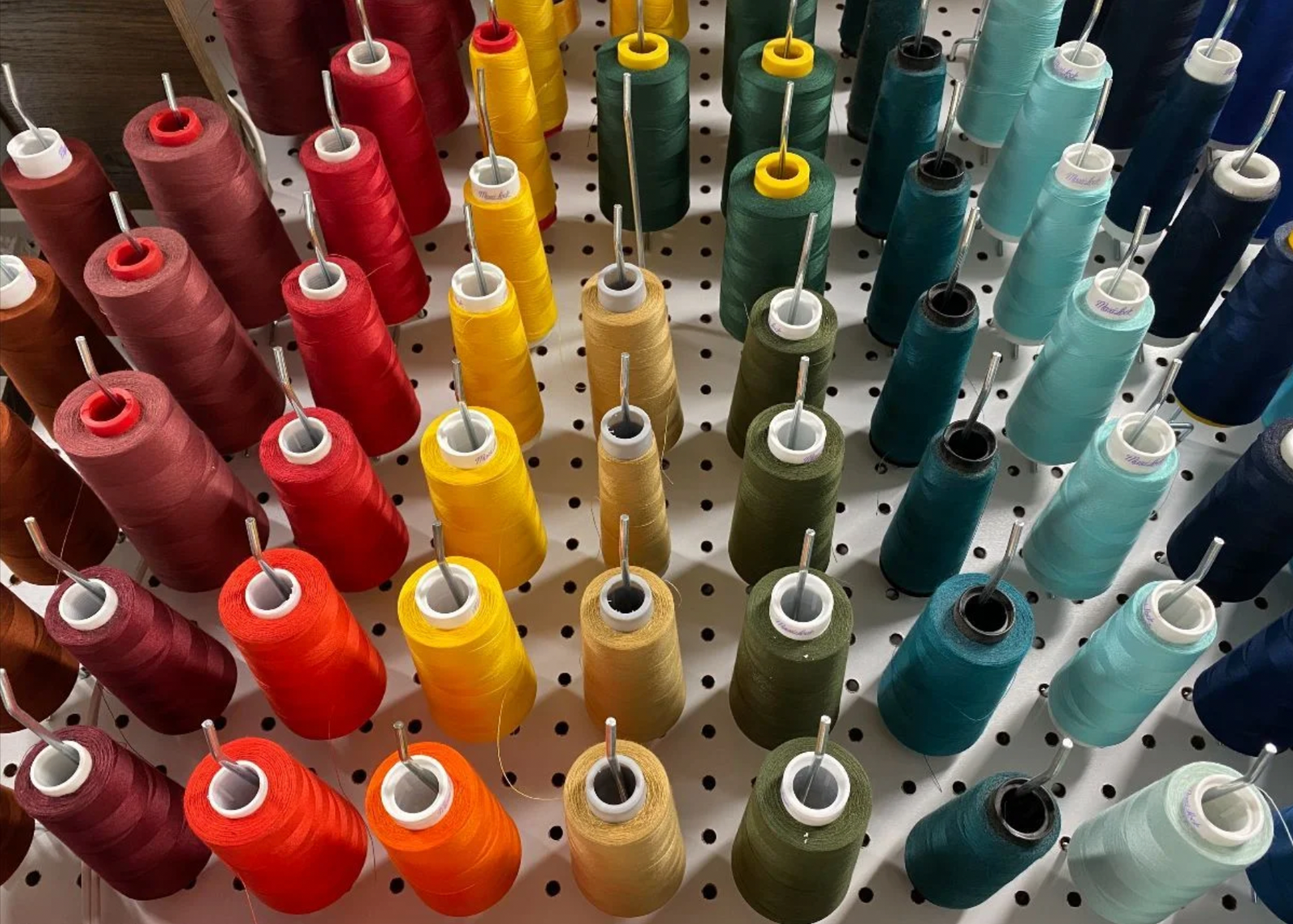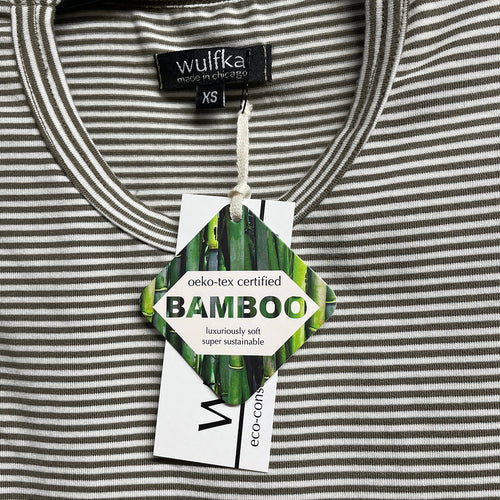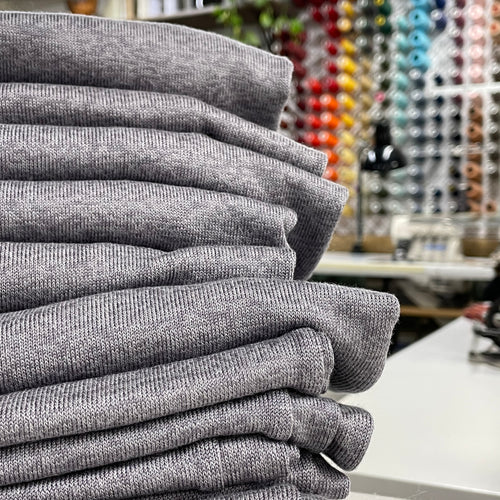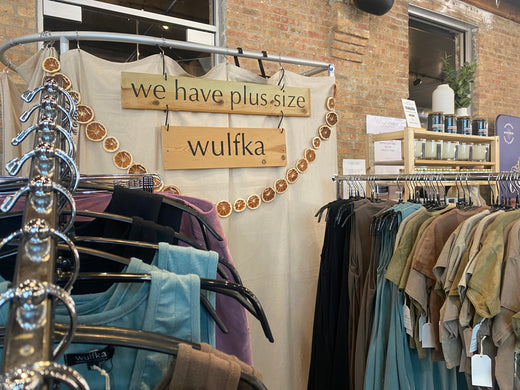Sustainable Fashion: Why We (Begrudgingly) Need Polyester

Originally posted August 12, 2021
I talk a lot of sh*t about polyester and synthetic fibers in general. Clothing made with synthetic fibers is the #1 source of microplastic in the ocean. Synthetic fibers take 400+ years to biodegrade, clogging landfills and poisoning the earth. They bond with oils from your body, promoting stinky bacteria growth. Disgusting. The worst. So why do we still need them, even in eco-conscious clothing?
For a quick refresher on what “synthetic fibers” means, here’s our handy dandy chart of the three basic categories of fiber:

Synthetic fibers are a form of plastic. Plastics come from petroleum. These fibers are very strong and very versatile, making them ideal in some circumstances.
Thread
All thread used to sew garments is polyester. Every single one of your garments has polyester thread. The Content Label refers to the fabric only, so even if the label says 100% Linen or something they’re not counting the thread.
Polyester is a “filament fiber,” which means it’s extruded like teeny tiny spaghetti thousands of meters long. This makes it the thread stronger and thinner than thread from natural fibers, which are just inches long and would require many fibers spun together. Polyester thread can zip through the twists and turns of a sewing machine without breaking! The quality is always consistent, and it won’t shrink in the wash. Super important qualities for any garment!

Logo Tags and Care Labels
I have never seen a label sewn into a garment that wasn’t made of polyester, including my Wulfka tags. Besides all the reasons listed under “Thread”, the ends can be heat sealed by a machine since plastic melts. There’s no itchy frayed ends, every label is exactly the same, and there’s no sewist tucking each end and sewing it!
Stretch
Synthetics like spandex and lycra are important for something that fabric aficionados call “regain.” We can make natural fibers stretchy by knitting them but we can’t keep them from stretching out. Regain is the ability to snap back into the original shape. Many knits have at least 3%-5% spandex, including my Tencel jersey. It keeps your garment looking as fresh as the first day you bought it, extending its life and usefulness. It also keeps your swimsuit from sagging!
Abrasion & Water Resistance
This is less relevant to Wulfka, but super important for upholstery, carpets, purse straps, shoes, the list is endless. Synthetics are strong and resilient, allowing them to be repeatedly rubbed, sat on, walked over, rained on, etc. It’s idealistic and impractical to say that all plastics should be abolished. Many things would wear out and need to be replaced much more frequently, causing more waste and more carbon emissions inherent in manufacturing anything.
I’m definitely calling myself out with this post. I started this blog series is to add nuance to the discussion of Sustainable Fashion and to stay honest with you about Wulfka. I don’t want to greenwash my own practices but I do believe that my fabrics, locally-made small batch manufacturing, and packaging are as eco-friendly as they could possibly be.
BUT I believe it will get better! New breakthroughs and new fabrics are always on the horizon, and here’s one I’m especially excited about:
Spider Silk
You know what’s super thin, super strong, comes thousands of meters long and can be stretchy? Besides polyester, I mean? YES it’s spider’s silk for weaving webs! I KNOW you’ve walked through a spider web and, even though a single thread was too thin to be visible, you couldn’t shake it off or even break it! Super creepy in a dark basement but absolutely tantalizing in a fabric lab!

Spider silk is the strongest fiber that exists. Like, literally stronger than Kevlar or steel at its miniscule diameter. Spiders can also extrude more or less stretchy silk, opting for the stretchier stuff in the center of the web. So why hasn’t spider silk completely replaced polyester? Because it’s too expensive and labor intensive to get! Spiders must be caught live, “milked” of their silk, and released (surely dazed and confused!) into the wild. This famous cape, made by Simon Peers and Nicholas Godley, took eight years and over a million “milkings” to create. (It’s at the Victoria and Albert Museum in London in case you’d like to take a gander).
Okay, not exactly a competitor for our dirt-cheap synthetics. Yet. Scientist David Breslauer and his team at Bolt Threads have been working to create a lab-made spider silk. Silk is a protein (check that graphic up at the top!) and humans have been biosynthesizing proteins for a long time. Insulin is, after all, a lab-made protein. Get this: The Bolt Threads lab has pioneered a process to brew the protein like beer and extrude it into fibers. The cherry on top? Color can be added directly to this “beer” to eliminate the need to dye later. (Aside from the dye process requiring lots of water, some dyes carry heavy metals and other toxins so eliminating that whole step is really really neat.)

There are still some issues to work out, but I’m super optimistic about this new technology and about folks’ interest in it. Breslauer said that when he first began his research investors weren’t interested in the eco-friendly aspects. He was pigeonholed into “novelty” and “tech” fabrics. A serge in enthusiasm has brought investors running to his door. And I think that’s a beautiful thing.
If you want to get stoked on Bolt Threads and the brave new world of biosynthetic fabrics, please check out this interview of Breslauer by Clare Press of the Wardrobe Crisis podcast. (And then go ahead and subscribe because if you read all of this so far, you’re a nerd like me and you’ll really like The Wardrobe Crisis!)




